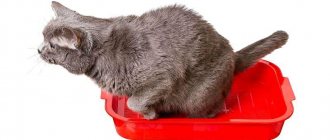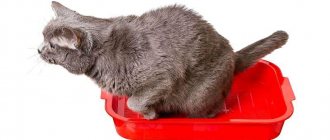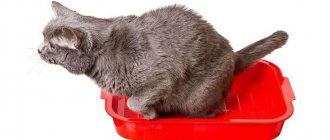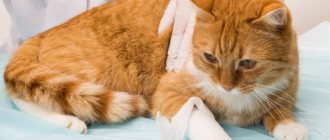The presence of scarlet drops or streaks in the feces is a signal that something is wrong in the cat’s body. This alarming symptom should not be ignored. After all, inaction can lead to severe internal bleeding and death of the pet. Therefore, it is important to understand the reasons for the appearance of blood in feces and in what cases the cat will need emergency hospitalization, and when treatment can be carried out at home.
Why does a cat poop blood?
If the owner regularly cleans the litter box, then without much difficulty and in time he will notice that his cat goes to the toilet with blood. Sometimes other impurities are found in stool that should not be there. For example, mucus, hair or helminth particles.
The most common reasons why this happens:
- Poor nutrition. If a cat is fed food from the human table - cereals, bread, or cheap cat food, this leads to digestive dysfunction. Your pet may become constipated, especially if there is insufficient drinking water. Dry feces damage the intestinal walls, so when your cat poops, blood appears in his stool.
- The pet eats bones. Cats should not be given bones, especially tubular ones, they are very hard and cannot be completely digested. Small sharp pieces injure the intestinal mucosa. As a result, the cat goes to the toilet with a lot of blood.
- A pet has swallowed a foreign body - a wood chip, a fragment of a toothpick, a small piece of plastic. Any small objects with sharp edges that injure the intestinal walls are dangerous.
- Food allergies. When an allergen enters the digestive tract, the body immediately reacts to it. An inflammatory process occurs in the intestines, which leads to disruption of the integrity of the mucous membrane. For this reason, a small amount of blood appears in the stool.
- Blockage of the intestines by hair. This problem is common in long-haired cats. When they lick, they swallow their hairs. Whole lumps accumulate in the stomach. The movement of food becomes difficult, and the pet becomes constipated. It becomes difficult for the cat to poop because the hardened feces are difficult to pass out and damage the rectum.
- Worms. Some types of helminths attach to the intestinal walls. They damage the mucous membrane, so the cat may poop with blood.
- Poisoning by poison. If a cat likes to hunt and goes out for walks, then it cannot be ruled out that she could have eaten a poisoned mouse. Rodent control products cause internal bleeding.
- Colitis. When the colon mucosa becomes inflamed, blood and mucus appear in the stool.
- Tumors. If your cat poops blood, there may be tumors in his digestive tract. They can be benign or malignant. During movement, feces touch the tumor and injure it, so blood is released.
- A side effect from taking certain medications. After treatment with antibiotics, the intestinal microflora is disrupted and dysbiosis develops. This may cause blood to appear in the stool.
- Infectious diseases. Some viruses can cause hemorrhage, but other alarming symptoms should also be present - fever, diarrhea, vomiting, lethargy. If a cat poops loose stool with bloody contents, most likely it is a viral disease. It is important to take him to the veterinary clinic as soon as possible, otherwise he will die from dehydration.
- Often cats poop with blood due to diseases of the internal organs - due to liver problems, stomach ulcers, and pancreatitis.
Little kittens are very curious. During the game, they strive to stick their nose everywhere, so they can get into trouble. Potential dangers for them include small objects on the floor and open packages of detergents or cleaning products.
An angry cat may accidentally knock over the bottle and step its paw into a puddle. Further actions are known - the pet will begin to lick itself and get poisoned.
In most cases, if a cat poops blood, the responsibility lies with the pet owner. It is important to ensure that liquid and bulk disinfectants and laundry detergents are kept out of reach.
Prevention
The origins of many diseases are in poor nutrition of pets. Therefore, the first preventive measure is to choose the right diet.
It must be remembered that:
- The cat should not eat only dry food;
- your pet should not be given large bones;
- It is not advisable to feed him from your table - not all the products we eat will benefit the cat.
To avoid missing the onset of serious diseases, regularly monitor your pet’s health at a veterinary clinic. If you find blood clots in the stool, be sure to take your pet for examination. The appearance of blood is never completely without reason!
Remember that no one knows your beloved pet better than you, and only you can notice changes in its condition. A timely identified problem and treatment will prolong the life of the fluffy, and in return he will certainly give you affection and love.
Description of blood in stool depending on the cause
If the owner of a cat discovers that he has started pooping blood, do not immediately panic. The unusual color of stool does not always indicate the presence of red blood cells. The color of the stool may change due to the vegetables your pet has eaten. For example, after eating beets, feces become reddish.
If the cat went to the toilet a lot and bloody clots or scarlet drops are clearly visible in the stool, most likely there are pathologies of the lower intestines. In this case, blood is released that has not been digested. It retains its original appearance. This picture is observed with damage to the colon, rectum or anus.
The problem can be difficult to detect for a person without knowledge of medicine or veterinary medicine. For example, if a cat poops black feces, the color indicates the presence of digested blood. This means that bleeding has opened in the stomach, duodenum or small intestine. In this case, the stool often has a specific smell.
Attention! Black feces can also happen for another reason - if the cat has eaten activated charcoal. The pet could find a tablet on the floor and, out of curiosity, feast on it.
Worms are a common problem in pets.
Signs of their presence in a pet’s body, as a rule, are not limited only to the presence of blood in cat feces. If a cat’s activity has decreased, it behaves sluggishly, there is practically no appetite, stool with blood is mostly liquid and sometimes vomiting occurs - in almost 9 such cases out of 10, when examining the animal, parasites are found. However, you don't need to do anything yourself.
Only a qualified doctor should diagnose the presence of worms and prescribe the necessary medications for treatment. Only he will be able to prescribe the correct dosage and regimen of medication.
We recommend reading: Symptoms and treatment of worms in cats
What to do before visiting a doctor
If a cat goes to the toilet with blood for the first time, this is a signal that something is wrong in its body. A consultation with a veterinarian is necessary, but if it is not possible to go to the clinic on the same day, you should take the following actions:
- Observe the condition of the pet. New symptoms may soon appear and will need to be reported to your doctor.
- Carry out deworming. It is advisable to buy a drug that acts on different types of helminths. After 10 days, treatment must be repeated.
- Clear the intestines of hairballs. A special paste will help with this. It is given daily, squeezing 4-5 cm out of a tube. Some cats eat it just like that, while others mix it into their food.
- Change your diet. When a cat poops blood, the first thing you need to do is change his diet. It is advisable to buy holistic food and make sure your pet drinks enough water.
If your cat frequently poops blood or has other alarming symptoms, the problem cannot be ignored. The situation may worsen sharply, and then it will be much more difficult to help the pet.
Professional intervention
On the other hand, if there are repeated sightings of blood accompanied by diarrhea or vomiting, your kitten may be facing a serious health problem that requires immediate veterinary attention. Bring a stool sample to your local veterinary clinic and your veterinarian can perform a series of tests, including an ultrasound, urine test, and abdominal x-ray to find out the real problem.
Based on an accurate diagnosis, it is expected that prescribing antibiotics will help eliminate bacterial infections. If your cat has parasites, deworming may be recommended. Additionally, natural supplements such as slippery elm extract may help your cat, but be sure to consult with your veterinarian before trying it. This is because some cats may develop allergic reactions to natural ingredients. At the same time, you should strictly follow your veterinarian's recommendations for a special diet for your cat in order to achieve the most desirable results in the recovery process.
Finally, closely monitor every change in his behavior day by day to see whether his health is improving or not. Contact your veterinarian immediately if the situation worsens and take immediate action.
When to seek help from a veterinarian
Emergency help is needed if the cat has severe bleeding. Other symptoms indicate this:
- black vomit;
- lethargy;
- dyspnea;
- loss of consciousness.
If such clinical signs appear, you must contact a veterinarian immediately, otherwise the cat will die. To at least slightly reduce blood loss, ice wrapped in a bag is placed on the pet’s stomach. The cat is taken to the clinic with its head down, this will help prevent hypoxia.
You cannot put off a visit to the veterinarian when a small kitten goes to the toilet with blood. Ignoring an alarming symptom can lead to the death of the baby. After all, at an early age, any ailment is dangerous - kittens develop rapidly infectious and parasitic diseases.
It is worth scheduling a visit to the veterinarian if your cat is pooping blood and has other signs of poor health:
- oppression, reluctance to play;
- loss of appetite;
- mucous or foamy inclusions in stool;
- pain during defecation - when the cat defecates, it begins to meow and arch its back;
- the animal poops irregularly, diarrhea alternates with constipation;
- sometimes there is vomiting;
- if blood appears in the cat’s stool while taking medications.
Diagnosis of the causes of bleeding in cats
The cat often goes to the toilet a little at a time
Helping a cat not go to the toilet with blood can only be done by eliminating the cause that caused the damage and treatment aimed at tissue regeneration. Only a veterinarian can select the appropriate therapy after conducting a comprehensive examination of the patient.
The doctor begins the appointment with an analysis of the person’s complaints that the kitten is pooping with blood, then he needs to obtain the most complete information about the living and nutritional conditions of his patient:
- Diet. The veterinarian needs to know whether dry or natural food predominates in the animal’s diet. How often and in what form does it receive vitamins? Additionally, the possibility of your pet eating bones is clarified. It is determined that there is free access to clean water.
- Infestation with parasites. Disturbances in the functioning of the digestive system often occur with helminthiasis, so the doctor needs to know the date of the last treatment. When planning an appointment with a veterinarian, it is recommended to clarify the name of the drug that was given to the cat to remove parasites.
- External condition. When cleaning the skin, long-haired animals can swallow lumps of hair, which sometimes injure the mucous membrane when passing through the intestines. High temperature, mucous discharge from the nose or eyes, lethargy may indicate the development of an infectious pathology. Bleeding that does not stop at rest, or an animal’s acute reaction to touch can become a signal of serious damage to the intestines, including as a result of cancer.
- Access to dangerous objects. The animal's tendency to check the trash can, play with unfamiliar things, climb into the most unpredictable places, and gnaw on plants is clarified.
- Going outside. Walking in the fresh air without control from the owner allows the animal to hunt, try different foods, even drink from puddles. All this leads to infection of the body.
- Associated symptoms. Temperature, appetite, and general condition can tell the veterinarian what caused the pathology.
The general condition of the cat can tell the veterinarian what was causing the concern.
A personal examination of the animal and a veterinarian interview with its owner is not enough to make a diagnosis. To find out the reason why kittens poop with blood, additional blood tests are prescribed, biochemistry, and laboratory testing of feces and urine are performed. Instrumental diagnostic methods are also used, including x-rays, ultrasound and colonoscopy.
If chronic inflammation in the intestinal tissues or tumor formation is suspected, the veterinarian resorts to a biopsy method. Taking a small piece of tissue for research is a painful procedure, so access to it is recorded quite rarely.
How to accurately diagnose the disease
Only a veterinarian can identify the exact reason why a cat is bleeding profusely. The animal owner’s task is to help the specialist collect anamnesis. During the consultation you will have to answer the following questions:
- what does a pet eat?
- does he go outside?
- whether there are poisonous plants or other substances hazardous to health in the house that the cat could reach.
The veterinarian will ask how often your pet poops with blood in it and if there are any other warning signs. For example, constipation, diarrhea, poor appetite, depression. During the examination, the cat's temperature is taken.
To establish the exact cause of blood in the stool, additional research will be needed:
- analysis of stool, urine and blood (general, allergen and biochemical);
- Ultrasound of internal organs;
- X-ray of the intestine;
- colonoscopy;
- If tumors are detected, a biopsy will have to be done.
Diagnosis of the condition
Diagnosis of the body’s condition is a prerequisite for a correct diagnosis. The doctor will conduct a general examination of the animal and prescribe blood, urine and feces tests. If necessary, the stomach is examined and an ultrasound of the abdominal organs is performed. Depending on the results of tests and examination, a course of treatment is prescribed.
Did you know? Ancient Greece is considered the ancestor of clinical diagnostic methods. Hippocrates, the founder of diagnostics, believed that the definition of a disease should be based on careful observation of the patient.
Wow.
How is the treatment carried out?
The treatment regimen for a cat that shits blood is developed individually, taking into account the cause of this symptom. When the test results are received, the veterinarian will prescribe medications and diet.
In some cases, surgery may be necessary. Cats with severe internal bleeding are treated in a hospital setting. In other cases, therapy takes place at home.
Effective medications
Since blood in a cat’s feces can appear for various reasons, the treatment is different in each case. List of drugs that are used for various pathologies:
- helminthic infestation - Drontal, Stronghold, Pirantel;
- problems with the liver or pancreas - Pancreatin;
- colitis – Enterol, Subtilis;
- allergies – Tavegil;
- infectious diseases – Gamavit, Fosprenil, Aminovit;
- bacterial infections – Enterofuril, Furazolidone;
- dysbacteriosis – Bifidumbacterin, Linex;
- hemostatic drugs - Etamzilat or Vikasol.
If an adult animal or kitten poops blood due to rat poison poisoning, then treatment should be started immediately. It includes gastric lavage and taking sorbents such as Enterosgel. In case of severe dehydration, the cat is treated with Regidron.
If the pet cannot drink, then the water balance is restored using droppers.
Traditional treatment
Folk remedies can only be used if the cat poops blood due to constipation. Vaseline oil is usually used to loosen stools. It is not absorbed in the upper intestines, but moves through it unchanged, lubricates the intestinal walls and softens the stool.
If your cat is often constipated, you need to look for the cause. Folk remedies give a short-term effect, but do not solve the problem.
The right approach to nutrition
During treatment, it is important to change the cat's diet. The main goal of the diet is to reduce the load on the digestive organs. Veterinarians recommend switching your pet to ready-made hypoallergenic holistic or super-premium food.
Bread, bones, fatty meat and processed foods should be excluded from the diet of a cat that shits blood. For constipation, you can add a little vegetable oil to the food. It is advisable to include fermented milk products in the daily menu - classic yogurt, kefir or yogurt.
Surgical intervention
The operation is indicated if:
- polyps or other neoplasms were discovered in the gastrointestinal tract;
- the pet has swallowed a foreign object;
- the cat cannot poop due to intestinal obstruction;
- internal bleeding began.
Associated symptoms
With different pathologies, various accompanying symptoms will appear.
Thus, urocystitis and urolithiasis are characterized by:
- Pollakiuria (frequent urination);
- Periuria (uncleanliness);
- Excessive licking of the groin area;
- Staying in the tray for a long time.
With urolithiasis, in addition to the fact that the cat pees with blood, there is a periodic inability to urinate (urethral blockage).
For kidney inflammation:
- General malaise, lethargy;
- Fever;
- Decreased appetite;
- Acute pain in the entire abdominal wall;
- Prolonged, painful urination;
- Cloudy or pink urine.
In case of injury:
- Acute tissue pain at the site of impact;
- Hematomas, abrasions.
Prostate diseases are characterized by:
- Painful, prolonged urination;
- Changing posture when urinating;
- Uncleanliness;
- Discharge from the prepuce;
- Inability to urinate;
- Much more common in uncastrated animals.
If a cat has diseases of the reproductive system, blood may appear in the urine for two reasons. First, inflammation of the uterus or vagina can trigger inflammation of the bladder (urocystitis). After all, the urethral canal is in close contact with the vagina. Secondly, vaginal discharge (with blood) can get into the urine from the outside when the cat pees.
Symptoms:
- Violation of the reproductive cycle, frequent estrus;
- Vaginal discharge;
- Excessive licking of the groin area;
- Increased thirst;
- Fever;
- Increased abdominal volume;
- Lethargy, drowsiness;
- Decreased appetite;
- Mastitis (inflammation of the mammary glands).
Balanoposthitis in a cat, in addition to hematuria, manifests itself:
- Hyperemia (redness) of the penis;
- Excessive licking of the groin area;
- Discharge from the prepuce;
- Prolonged, painful urination.
Orchitis can only occur in uncastrated males. The urethra connects to the vas deferens, so if there is blood in the semen, it will appear in the cat’s urine from time to time.
Characteristics of orchitis:
- Swelling and tenderness of the testis/testes;
- Cats that are sexually active are susceptible;
- The frequency of urination may not change.
Preventive actions
The appearance of bloody inclusions in your pet’s stool can be prevented by following these recommendations:
- feed the cat high-quality food, do not give it prohibited foods and treats;
- do not leave small objects on the floor that the cat could swallow;
- worm your pet regularly;
- adhere to the routine vaccination schedule;
- ensure that the cat has constant access to clean drinking water;
- Brush the coat 2 times a week;
- do not let the animal go for a walk unattended;
- Store powder and disinfectants out of reach;
- For any alarming symptoms, seek veterinary help.
There are many reasons why cats poop blood – from dysbacteriosis and allergies to oncology. In any case, do not put off visiting the veterinarian. After all, timely diagnosis of diseases is the key to successful treatment.











